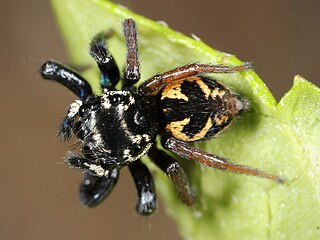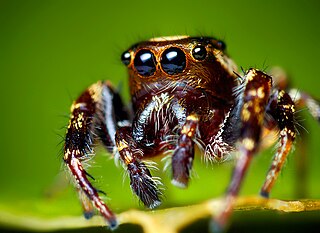
Habronattus is a genus in the family Salticidae. Most species are native to North America. They are commonly referred to as paradise spiders due to their colorful courtship ornaments and complex dances, similar to birds-of-paradise. Males display intricate coloration, while females are cryptic.
Antillattus is a genus of Caribbean jumping spiders that was first described by E. B. Bryant in 1943. The name is a combination of "Antilles" and the common ending for salticid genera -attus.

Beata is a genus of jumping spiders that was first described by George Peckham & Elizabeth Peckham in 1895.

Compsodecta is a genus of Caribbean jumping spiders that was first described by Eugène Louis Simon in 1903.
Coryphasia is a genus of jumping spiders that was first described by Eugène Louis Simon in 1902.

Corythalia is a genus of jumping spiders that was first described by Carl Ludwig Koch in 1850. The genus is distributed throughout most of the Western Hemisphere. Species of this genus are found in The Americas.

Eris is a genus of the spider family Salticidae. It is native to North and South America. As is typical for salticids, they are not defensive. While larger specimens could potentially bite, an envenomation would pose no danger to a human.

Hentzia is a genus of the spider family Salticidae subfamily Dendryphantinae. The genus is widespread in North America and northern South America but the center of biodiversity seems to be primarily in the Caribbean and surrounding areas, with the greatest species diversity occurring in Cuba, which has seven species. Some outlier species, such as Hentzia poenitens and Hentzia fimbriata are found in western North America. It appears to be closely related to the genus Anicius from which it differs primarily in certain anatomical details.

Jollas is a genus of jumping spiders (Salticidae), found in Central America, the Caribbean and South America.

Messua is a spider genus of the family Salticidae.
Pristobaeus is a genus of jumping spiders that was first described by Eugène Louis Simon in 1902.

Sidusa is a genus of jumping spiders that was first described by George and Elizabeth Peckham in 1895.

Zenodorus is a genus of the jumping spiders distributed from the Moluccas to Australia, including several islands of the Pacific. It was once considered a junior synonym of Omoedus, but this was later rejected by Jerzy Prószyński in 2017. At least one species, Z. orbiculatus, specializes on hunting ants.

George Williams Peckham and Elizabeth Maria Gifford Peckham were a married couple who were early American teachers, taxonomists, ethologists, arachnologists, and entomologists, specializing in animal behavior and in the study of jumping spiders and wasps.

Euophryini is a tribe of jumping spiders. Most spiders in this tribe have a spiral embolus that faces ventrally.
Corticattus is a genus of Caribbean jumping spiders that was first described by J. X. Zhang & Wayne Paul Maddison in 2012. As of June 2019 it contains only two species, found only on Hispaniola and in Puerto Rico: C. guajataca and C. latus.
Popcornella is a genus of Caribbean jumping spiders that was first described by J. X. Zhang & Wayne Paul Maddison in 2012.
Truncattus is a genus of Caribbean jumping spiders that was first described by J. X. Zhang & Wayne Paul Maddison in 2012.

Hisponinae is a subfamily of jumping spiders. The subfamily has six known extant genera and three extinct genera.













